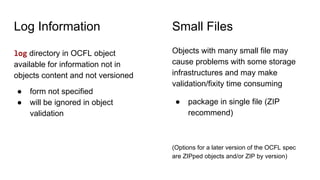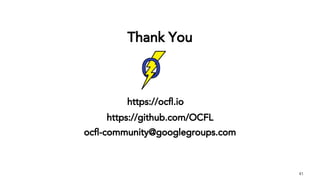This document provides an overview of the Oxford Common File Layout (OCFL) specification for digital preservation. It summarizes the goals of OCFL, which are to enable the completeness, parsability, robustness, and storage of digital objects on a variety of infrastructures. The key components of an OCFL system include OCFL objects, which group content files and metadata into versioned directories, and OCFL storage roots, which provide a hierarchical storage structure for multiple OCFL objects.

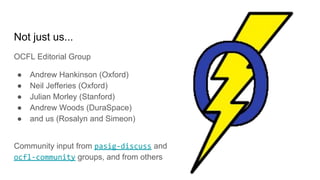


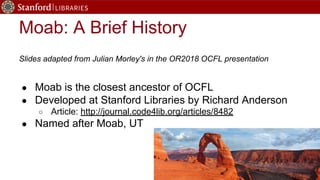



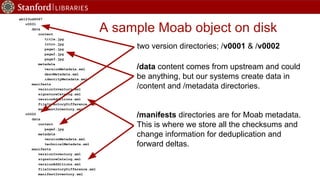



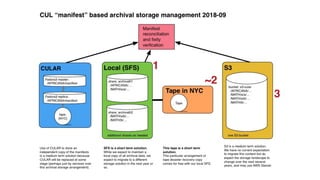


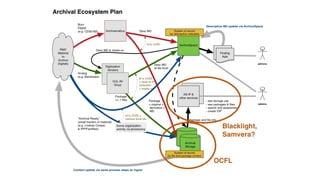

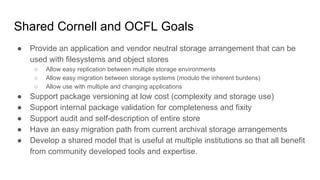








![OCFL Object
A group of one or more content files and
administrative information identified by a
URI.
The object may contain a sequence of versions
of the files organized into version directories.
The base directory of the object may contain a
logs directory.
A NAMASTE file indicating conformance.
An object contains an inventory digest file
which provides a digest for the
inventory.json file.
[object root]
├── 0=ocfl_object_1.0
├── inventory.json
├── inventory.json.sha512
├── v1
│ ├── empty.txt
│ ├── foo
│ │ └── bar.xml
│ ├── image.tiff
│ ├── inventory.json
│ └── inventory.json.sha512
├── v2
│ ├── foo
│ │ └── bar.xml
│ ├── inventory.json
│ └── inventory.json.sha512
└── v3
├── inventory.json
└── inventory.json.sha512](https://image.slidesharecdn.com/2018-10ocflsamvera-181018233743/85/Oxford-Common-File-Layout-OCFL-27-320.jpg)
![OCFL Object
An object contains an inventory.json file
which inventories the contents of an object.
The manifest block lists all the digests and
existing file paths for all of the object’s content.
The versions block identifies the logical file path
and the digest for each version of the object’s
content.
Separating the logical file path from the
existing file path and using digests to refer to
files allows for deduplication of content.
{
"head": "v3",
"id": "ark:/12345/bcd987",
"manifest": {
"4d27c8...b53": [ "v2/foo/bar.xml" ],
"7dcc35...c31": [ "v1/foo/bar.xml" ],
"cf83e1...a3e": [ "v1/empty.txt" ],
"ffccf6...62e": [ "v1/image.tiff" ]
},
"type": "Object",
"versions": [
{
"created": "2018-01-01T01:01:01Z",
"message": "Initial import",
"state": {
"7dcc35...c31": [ "foo/bar.xml" ],
"cf83e1...a3e": [ "empty.txt" ],
"ffccf6...62e": [ "image.tiff" ]
},
"type": "Version",
"user": {
"address": "alice@example.com",
"name": "Alice"
},
"version": "v1"
},
{
"created": "2018-02-02T02:02:02Z",
"message": "Fix bar.xml, remove image.tiff,](https://image.slidesharecdn.com/2018-10ocflsamvera-181018233743/85/Oxford-Common-File-Layout-OCFL-28-320.jpg)
![OCFL Storage Root
The base directory of an OCFL storage layout.
Should also contain the OCFL specification in
human-readable plain-text format.
Should contain the conformance declaration
OCFL Objects may conform to the same or
earlier version of the specification.
The storage hierarchy must terminate with an
OCFL Object Root.
[storage root]
├── 0=ocfl_1.0
├── ocfl_1.0.txt (optional)
├── ab12cd34
│ ├── 0=ocfl_object_1.0
│ ├── inventory.json
│ ├── inventory.json.sha512
│ └── v1
│ ├── file.txt
│ ├── inventory.json
│ └── inventory.json.sha512
└── ef56gh78
. ├── 0=ocfl_object_1.0
├── inventory.json
├── inventory.json.sha512
├── v1
│ ├── empty.txt
│ ├── foo
│ │ └── bar.xml
│ ├── image.tiff
│ ├── inventory.json
│ └── inventory.json.sha512
└── v2
├── foo
│ └── bar.xml
├── inventory.json
└── inventory.json.sha512](https://image.slidesharecdn.com/2018-10ocflsamvera-181018233743/85/Oxford-Common-File-Layout-OCFL-29-320.jpg)
![OCFL Storage Root
Storage hierarchies must not include files
within intermediate directories
Storage hierarchies must be terminated by
OCFL Object Roots
Storage hierarchies within the same OCFL
Storage Root should use just one layout
pattern
Storage hierarchies within the same OCFL
Storage Root should consistently use either a
directory hierarchy of OCFL Objects or
top-level OCFL Objects
[storage root]
├── 0=ocfl_1.0
├── ocfl_1.0.txt (optional)
└── ab
└── 12
└── cd
└── 34
└── ab12cd34
├── 0=ocfl_object_1.0
├── inventory.json
├── inventory.json.sha512
├── v1
│ ├── empty.txt
│ ├── foo
│ │ └── bar.xml
│ ├── image.tiff
│ ├── inventory.json
│ └── inventory.json.sha512
└── v2
├── foo
│ └── bar.xml
├── inventory.json
└── inventory.json.sha512](https://image.slidesharecdn.com/2018-10ocflsamvera-181018233743/85/Oxford-Common-File-Layout-OCFL-30-320.jpg)


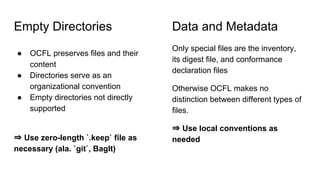

![Storage Root Hierarchy - flat, pairtree, ex-wye-zee
[storage_root]
├── 0=ocfl_1.0
├── ocfl_1.0.txt (optional)
├── d45be626e024
| ├── 0=ocfl_object_1.0
| ├── inventory.json
| ├── inventory.json.sha512
| └── v1...
├── d45be626e036
| ├── 0=ocfl_object_1.0
| ├── inventory.json
| ├── inventory.json.sha512
| └── v1...
├── 3104edf0363a
| ├── 0=ocfl_object_1.0
| ├── inventory.json
| ├── inventory.json.sha512
| └── v1...
[storage_root]
├── 0=ocfl_1.0
├── ocfl_1.0.txt (optional)
├── d4
| └── 5b
| └── e6
| └── 26
| └── e0
| ├── 24
| | └──d45be626e024
| | ├──
0=ocfl_object_1.0
| | └── ...
| └── 36
| └──d45be626e036
| ├──
0=ocfl_object_1.0
| └── ...](https://image.slidesharecdn.com/2018-10ocflsamvera-181018233743/85/Oxford-Common-File-Layout-OCFL-35-320.jpg)



